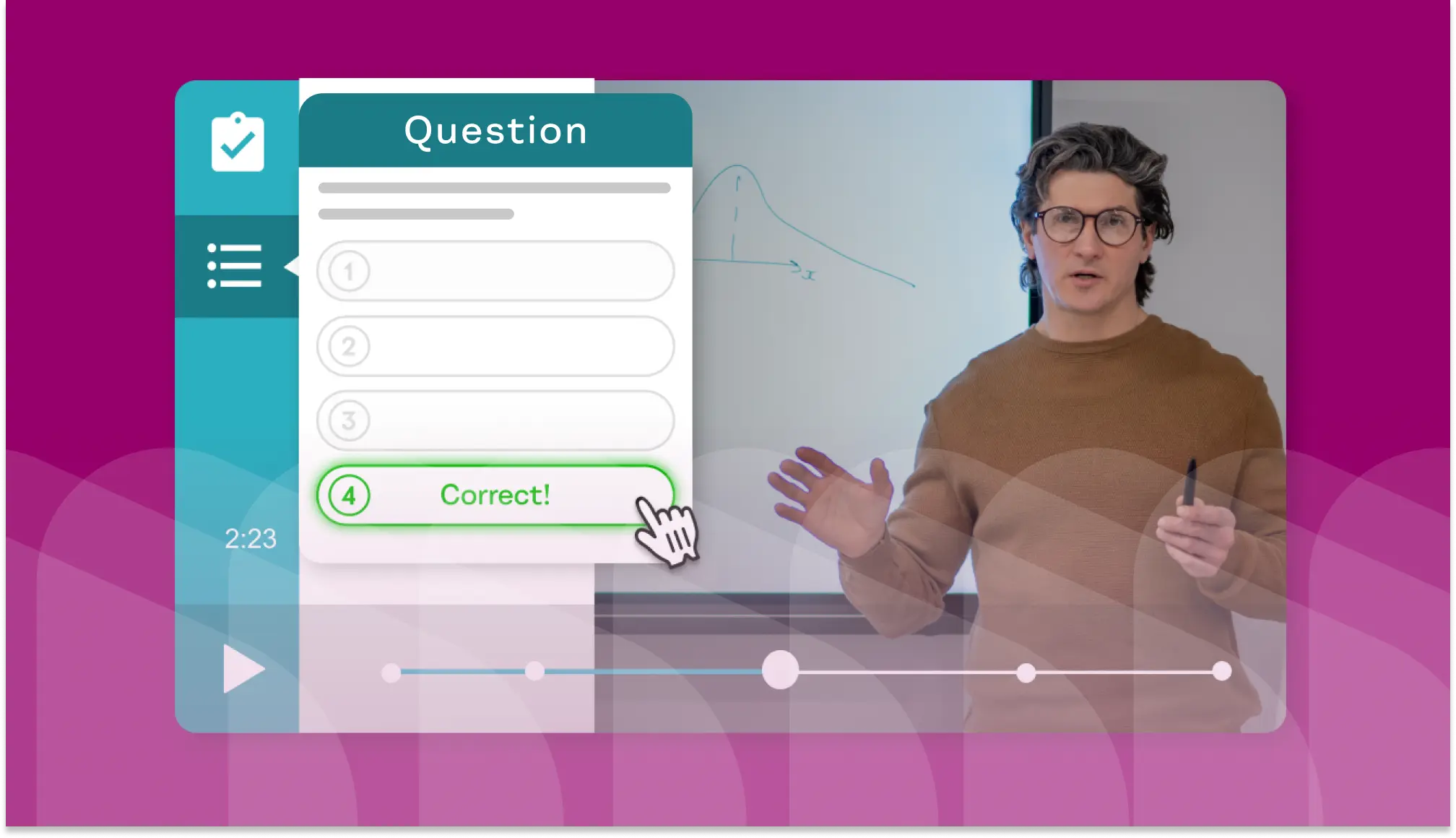
Interactive videos provide powerful results: 66 percent more engagement and a 44 percent longer viewing time compared with traditional videos. Interactive videos go beyond play, pause, fast forward, and rewind. They turn uninterested viewers into intrigued participants. Let's look at eight interactive video examples and find out how they encourage deeper learning.
1. SBS uses an interactive video to educate participants on a near-extinct language
The Marra language faces extinction. When Angelina Joshua's grandmother passed away, the world lost one of the only three remaining speakers of the indigenous Aboriginal language. Joshua's compelling story shows one of the most powerful interactive video examples online.
"My Grandmother's Lingo" begins with a clever tagline: this story needs your voice. Viewers learn five words attached to Joshua's story. One Marra word, Wardgarr, meaning fire, sets the theme of one of several scenes in the 10-minute video.
As the video explains, a language flickers out every two weeks. Preserving indigenous languages proves an enormous task. Video moves us. Interactive video examples highlight the evolution of the medium.
2. Interactive video examples like Cisco's utilize multiple choice questions
WATCH: Cisco’s multiple choice quiz interactive video
Instead of showing a static video and handing out a post-assessment, Cisco's learning and development (L&D) team embedded multiple-choice questions into their video. With modern educational technology, content creators and teachers can achieve great results without a production or development team. Don't have a green screen? No problem. WeVideo provides all the tools you'll need to create powerful interactive videos.
Cisco's educational video tests a viewer's understanding of English phrases with comprehension questions.
The hearts at the top add an element of gamification, which helps keep learners engaged and enhances the learning experience. Employing gamification in video content can turn passive viewers into active learners, enabling them to grasp and retain content.
By strategically inserting quizzes, polls, or interactive annotations at appropriate points within a video, learners can be paused, asked to explore further, and asked to reflect on what they've seen. The learner receives immediate feedback.
3. CPR and AED training using interactive video
WATCH: Resuscitation Council UK’s Lifesaver interactive videos
Emergencies trigger a fight, flight or freeze response. The Resuscitation Council UK created Lifesaver, a series of interactive videos, training, and resources to help participants think through real-world scenarios. These interactive video examples present viewers with choices as they proceed.
After a fictional character, Harry, passes out on the ground, the viewer is asked what to do — try to get a response. Correct. Then, how do you get a response?
The video walks through the entire process of administering CPR and using an AED. In Lifesaver's interactive video examples, the viewer joins in helping save a life. Traditional CPR training videos show what to do. Interactive videos involve the audience in the action.
4. Interactive video examples promote creativity and imagination
WATCH: An interactive video for educators by the British Council
Cultivating creativity is one of the most critical aspects of education. The British Council understands this truth and has several interactive video examples like the one above that use fun animations and multiple-choice scenarios to help teachers explore how to encourage creativity in young students.
Using tools like WeVideo's interactive video design studio, PlayPosit, users can easily create videos like the one above, adding a variety of interactions including:
- Multiple Choice: Learners need to choose one correct answer from a list of answer options.
- Check All: Learners need to choose all the correct answers from a list of answer options.
- Free Response: Learners answer the question by submitting their responses in text, image, or audio format.
- Fill-in-the-blank: Present learners with a phrase missing one or more words. Questions can have multiple blanks and multiple correct answers.
- Poll: Learners select one or more options from a list of answer options.
- Discussion: Learners can post comments and reply to their peer's posts in real time. Instructors can monitor and delete the post if needed.
- Pause: Pause the video playback and display the information entered by the instructor.
- Web Embed: Embed a website in the video player that allows learners to explore the website without leaving the video.
- PDF file: Upload the PDF file from the device or import the PDF file with the link as an interaction. Learners can use the built-in tool to add comments, highlight texts, and draw on the PDF file.
LEARN MORE: Create an Interactive Video in Three Easy Steps with Templates
5. Amazon prepares its customer service agents for the role
WATCH: Amazon trains its Customer Service Agents using interactive
In one of Amazon's Customer Service Agent (CSA) training videos, viewers follow an animated character, Amy, and take part in the role. The video shows the power of interactive video in highlighting critical information and directing viewers toward supplemental readings.
6. California Community College develops compelling interactive video on time management
WATCH: An interactive video teaches student time management skills
Teaching students time-management skills is essential to helping them succeed in college. The video introduces students to time management and its importance in their success.
Students then take a short quiz that helps them identify their time management style. They are presented with one of four options: the improviser, the pressure cooker, the balancing act, and the early bird.
Interactive elements promote active participation and improve cognitive connections. Attention spans continually shorten. Interactive video examples show how actively engaging viewers can result in higher-order thinking and problem-solving skills. Moreover, interactive videos facilitate personalized learning experiences and provide real-time feedback, vastly improving learning outcomes.
For many of the interactive video examples mentioned, achieving the desired result requires two or more video tools: one for recording, another for editing, and another for adding interactivity.
WeVideo does it all.
Need to record from a webcam and screen simultaneously? No problem. It's all included in our software. This feature makes creating content such as product demos and webinars easier for business customers. Simultaneously recording from a webcam and screen is also popular among YouTubers, most notably avid gamers and those who create and share DIY tutorials.
On the education side, teachers can create instructional videos for their classrooms or professional development with fellow teachers. Students can use this new feature to show their thought processes through video. This could include reflecting through video journals, explaining their solution path in math, or annotating informational or literary texts.
And don't worry — if start-from-scratch video creation isn't your priority, our interactive video tools allow you to turn any existing video content into a dynamic, interactive experience for learners.
7. Two truths and a lie in video form
WATCH: Interactive video has the power to connect people like in this video.
Educators and L&D professionals must foster relationships and collaboration when learners live miles apart. In higher education, part of the formal evaluation process of online courses considers how learners interact with the materials and their peers within the course.
In interactive video examples like the one shown, educators can see how using interactive video to get to know a remote classmate could help foster relationships even at a distance.
8. Information on a co-working space receives an interactive twist
WATCH: Giving viewers a choice is a powerful benefit of interactive video.
The interactive video examples created by Groundswell Startups -- a co-working space and startup incubator -- show how to provide autonomy in a viewer experience. Interactive video allows for a unique experience.
Each person participating in the video has unique needs.
After a quick introduction, the viewer can choose from six video options: co-working, events, mentors, offices, amenities, and a contact page. This user experience allows viewers to access the use case that matters most to them.
The interactive video examples above highlight the power of turning passive, linear videos into engaging learning experiences. Viewers join in. They make decisions. They acquire new knowledge as active participants.
Discover how educators and training maximize outcomes with interactive video



